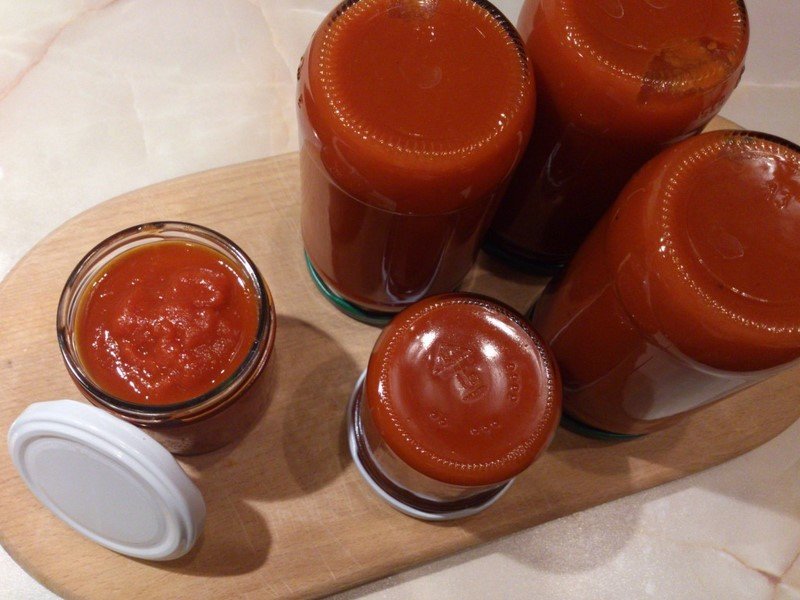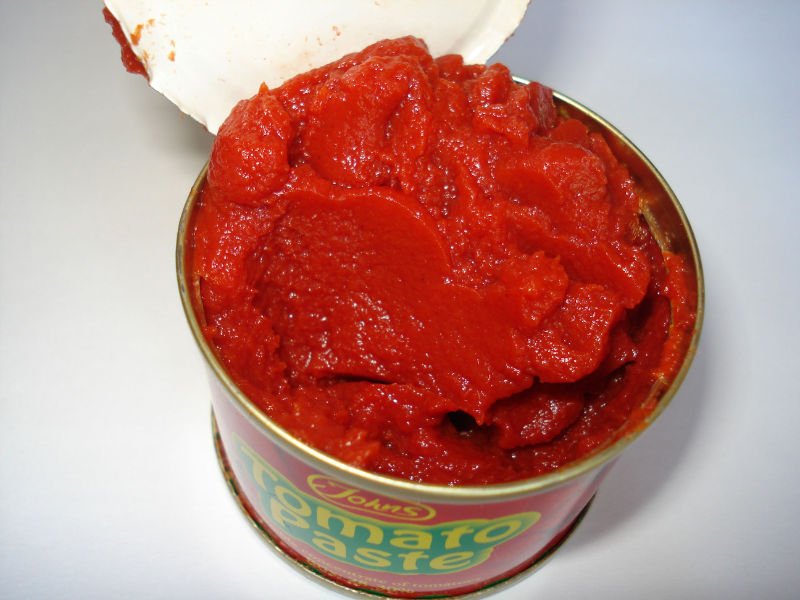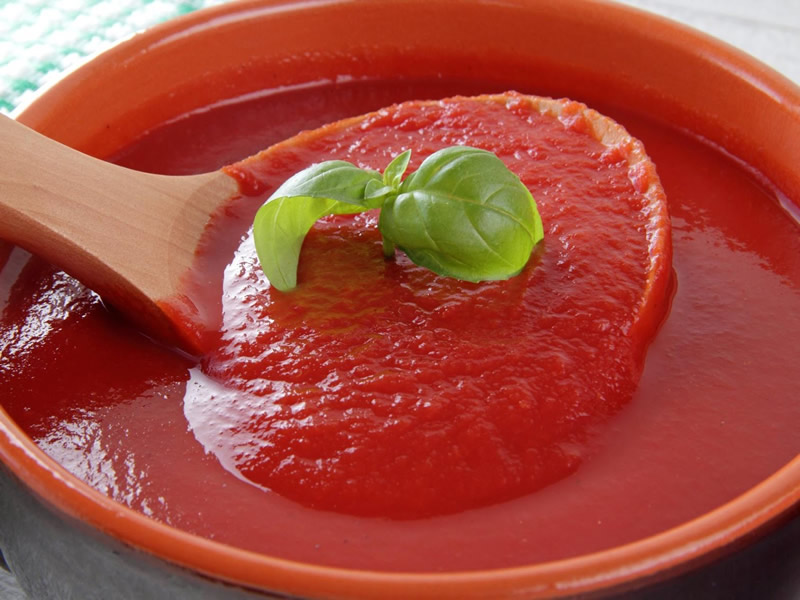Tomato paste and tomato sauce are two commonly used ingredients in cooking that come from tomatoes. While they may appear similar, there are several differences between the two in terms of their taste, texture, consistency, and applications. In this summary, we will explore the distinctions between tomato paste and tomato sauce to better understand their unique characteristics and uses.
Tomato paste is a concentrated, thick paste made by cooking tomatoes for an extended period and removing the skin and seeds. It is rich in flavor and has a deep, intense taste due to the concentration process. Tomato paste is known for its vibrant red color and smooth texture. It is commonly sold in tubes or small cans.
On the other hand, tomato sauce is a more diluted form of tomatoes that undergoes a longer cooking process with the addition of various spices, herbs, and other ingredients. It has a smoother consistency compared to tomato paste and is often used as a base for many dishes. Tomato sauce usually has a milder flavor compared to tomato paste and is typically sold in jars or cans.
One of the main differences between tomato paste and tomato sauce lies in their uses in different culinary applications. Tomato paste is primarily used to add depth and richness to dishes. It is commonly used as a base for sauces, stews, soups, and marinades. Due to its concentrated flavor, tomato paste is often used in small quantities and mixed with other liquids to bring out the desired taste. It is an essential ingredient in dishes like bolognese sauce, chili, and curry.
Tomato sauce, on the other hand, provides a more balanced and lighter flavor to dishes. It is often used as a topping for pizzas, pasta dishes, and in recipes where a smoother texture is preferred. Tomato sauce is versatile and can be used as a base for various Italian and Mediterranean-inspired dishes. It is also a popular condiment for burgers, sandwiches, and as a dipping sauce.
In terms of consistency, tomato paste is much thicker compared to tomato sauce. Its concentrated nature makes it a denser and more intensely flavored ingredient. Tomato paste can be quite sticky and may need to be diluted with liquids like water, broth, or wine to achieve the desired consistency in dishes. Tomato sauce, on the other hand, has a smoother and more liquid consistency, making it easier to pour and spread.
Another distinction between tomato paste and tomato sauce is their shelf life. Tomato paste, due to its concentration and absence of additional ingredients, has a longer shelf life and can be stored for months, even years, without refrigeration. Tomato sauce, especially if it contains added ingredients like spices, can have a shorter shelf life and typically needs to be refrigerated once opened.

When it comes to nutritional value, both tomato paste and tomato sauce offer health benefits. Tomatoes, in general, are rich in vitamins C and A, antioxidants, and dietary fiber. However, it’s important to note that tomato paste may be more nutritious in certain aspects due to its concentrated form. It contains higher levels of lycopene, a powerful antioxidant known for its potential anti-cancer properties. Additionally, tomato paste is also a good source of iron, potassium, and vitamin K. Tomato sauce, on the other hand, tends to have a lower concentration of these nutrients due to the dilution process and the addition of other ingredients.
In summary, tomato paste and tomato sauce are two distinct tomato-based ingredients with varying taste, consistency, and uses. Tomato paste is a concentrated, thick paste used to add depth and intensity to dishes, while tomato sauce has a smoother texture and milder flavor, making it an ideal base or topping for various recipes. Tomato paste is thicker and has a longer shelf life compared to tomato sauce. Lastly, tomato paste tends to be more nutritious due to its concentrated form, while tomato sauce is more diluted in terms of nutrients. Understanding these differences can help in making the right choice for various culinary creations.Tomato Paste vs Sauce: Exploring the Differences and Their Business Implications
Introduction:
Tomato paste and tomato sauce are staple ingredients in many kitchens worldwide, but understanding their differences is essential for businesses in the food industry. From manufacturers to restaurants and food service providers, it is crucial to comprehend the distinctions between these tomato products to make informed decisions regarding sourcing, recipe development, and customer preferences. In this article, we will delve deeper into the topic of tomato paste vs sauce, highlighting their taste, texture, uses, market demand, and potential business considerations.
1. Flavor and Texture:
Tomato paste, with its concentrated form, offers a rich and intense flavor profile, making it an ideal choice for adding depth to dishes. Its thick texture can provide a robust base for sauces, stews, and even marinades. On the other hand, tomato sauce possesses a milder flavor and smoother texture, offering a balanced taste that can be readily enjoyed as a topping or used as a base for various Mediterranean and Italian-inspired dishes.
2. Culinary Applications:
Businesses in the food industry must understand the culinary applications of tomato paste and sauce to cater to diverse consumer needs. Tomato paste is commonly used in recipes that require a stronger and more concentrated tomato flavor, such as bolognese sauce, chili, and curry. Alternatively, tomato sauce is well-suited for pizzas, pasta dishes, and as a condiment for burgers and sandwiches. By considering these applications, businesses can offer a wide range of products and menu options to cater to different customer preferences.

3. Shelf Life and Storage:
Tomato paste and tomato sauce differ in terms of shelf life and storage requirements, an aspect that businesses need to keep in mind. Tomato paste, due to its concentrated nature, has a longer shelf life compared to tomato sauce. It can be stored for several months, even years, without refrigeration. This characteristic makes it an attractive option for manufacturers and suppliers as it allows for longer production and distribution cycles without compromising product quality. Tomato sauce, however, typically requires refrigeration once opened and may have a shorter shelf life, especially if it contains added ingredients like spices or herbs.
4. Packaging and Distribution:
Packaging plays a crucial role in maintaining the quality and integrity of tomato paste and sauce. Manufacturers and suppliers must choose appropriate packaging materials and formats that extend shelf life and preserve flavor. Tomato paste is commonly sold in tubes or small cans, offering convenience and easy portioning for consumers. Tomato sauce, on the other hand, is usually packaged in jars or cans, providing a wider range of sizes suitable for both household and commercial use. Considering effective packaging and distribution strategies allows businesses to enhance their market presence and meet customer demands efficiently.
5. Nutritional Value:
Businesses in the food industry should also consider the nutritional aspects of tomato paste and sauce to cater to health-conscious consumers. Tomato paste, being more concentrated, tends to be more nutrient-dense compared to tomato sauce. It contains higher levels of lycopene, a potent antioxidant, as well as iron, potassium, and vitamin K. These nutritional benefits can be highlighted in marketing efforts, appealing to consumers looking for healthy and nutritious options. However, it is essential to note that tomato sauce can also provide health benefits, including vitamins A and C and dietary fiber, albeit in slightly lower concentrations.
6. Market Demand and Trend Analysis:
Understanding market demand and current trends surrounding tomato paste and sauce can aid businesses in making strategic decisions. Market research and trend analysis provide valuable insights into consumer preferences, allowing manufacturers, restaurants, and food service providers to align their product offerings accordingly. For example, the increasing popularity of plant-based diets and the demand for organic and natural food products have led to a rise in alternative tomato-based sauces, such as vegan-friendly and preservative-free options. Being well-informed about market dynamics empowers businesses to capitalize on emerging opportunities and create products that cater to specific target audiences.

7. Ingredient Sourcing and Quality Assurance:
For businesses engaged in the production or sourcing of tomato-based products, ensuring high-quality ingredients is paramount. The choice between tomato paste and tomato sauce suppliers is essential to maintain consistency, flavor, and overall product quality. Businesses should consider factors such as the tomato variety used, cultivation methods, and processing techniques employed by the suppliers. Conducting rigorous quality assurance checks, including testing for flavor, color, texture, and nutritional content, helps maintain the desired product standards and customer satisfaction.
8. Recipe Development and Innovation:
Businesses involved in recipe development can leverage the distinct characteristics of tomato paste and sauce to create unique and exciting culinary creations. Experimenting with different ratios of tomato paste and sauce can yield innovative flavor profiles suited for specific dishes or target markets. By exploring recipe development and staying open to creative possibilities, businesses can differentiate themselves from competitors and offer innovative tomato-based products that capture the interest of consumers.
9. Cost Considerations:
When comparing tomato paste and sauce for business purposes, cost considerations play a significant role. Tomato paste, as a more concentrated product, has a higher price point compared to tomato sauce. Businesses that utilize tomato paste in their recipes may incur higher ingredient costs, which need to be carefully balanced against the desired flavor and quality. Alternatively, tomato sauce, with its more diluted form, offers a more cost-effective option for businesses wanting to provide a tomato-based ingredient without compromising on taste.
10. Consumer Education and Transparency:
Educating consumers about the differences between tomato paste and sauce can create transparency and build trust in the products offered by businesses. Providing clear and informative labeling about the ingredients used, the processing methods employed, and the unique characteristics of tomato paste and sauce can help consumers make informed purchasing decisions. By emphasizing the quality, flavor, and versatility of the tomato-based products they offer, businesses can build strong customer loyalty and foster long-term relationships.

Conclusion:
In conclusion, understanding the differences between tomato paste and tomato sauce is vital for businesses in the food industry. From flavor and texture variations to culinary uses, shelf life, packaging, nutrition, and market demand, several factors must be considered when making business decisions regarding these tomato products. By leveraging these distinctions and considering cost, ingredient sourcing, recipe development, and consumer education, businesses can develop innovative, market-oriented offerings that cater to different tastes and preferences. With a comprehensive understanding of tomato paste and sauce, businesses can position themselves strategically, meet customer demands, and thrive in the competitive food industry landscape.









